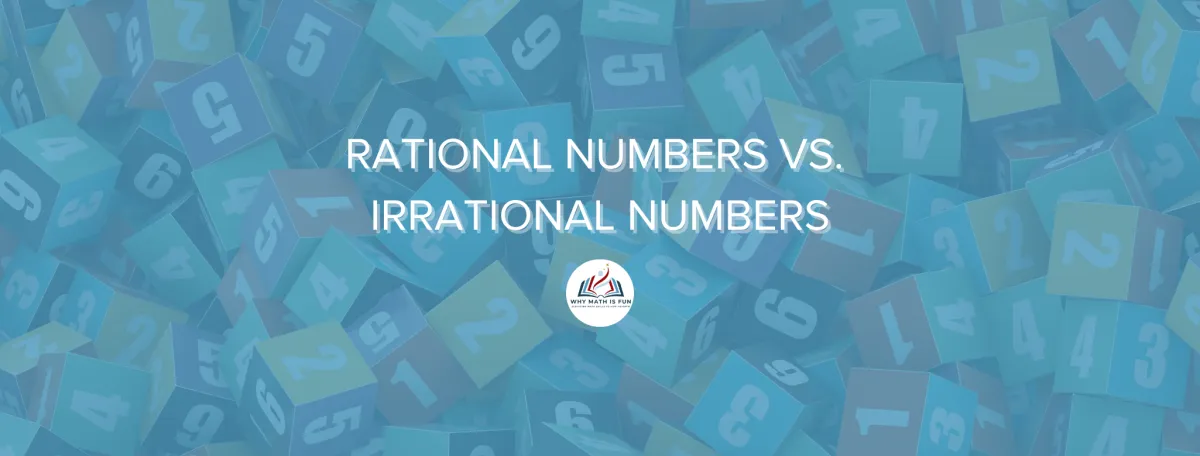
Difference between rational and irrational numbers with examples
Rational numbers and Irrational Numbers
What is a rational number?
A rational number is a type of number that can be written as the quotient or fraction of two integers, where the numerator is an integer and the denominator is a non-zero integer. In other words, any number that can be expressed in the form a/b, where a and b are integers and b ≠ 0, is considered a rational number. For example, 1/2 is a rational number because it is the result of dividing the integer 1 by the non-zero integer 2. Rational numbers include not only fractions like 3/4 and -5/6, but also whole numbers and integers, since numbers like 4 or -3 can be written as 4/1 and -3/1, respectively.

What are rational numbers?
Rational numbers are numbers that can be expressed as a fraction or ratio of two integers, where the denominator is not zero. In other words, a rational number is any number that can be written in the form a/b, where a and b are integers and b ≠ 0. These numbers can be positive or negative, and they include whole numbers, integers, fractions, and certain decimals.
Rational numbers also include decimals that either terminate (such as 0.75) or repeat in a pattern (such as 0.333...). Every rational number has a unique decimal representation, which can help us compare the size or value of different rational numbers. For example, the fraction 1/4 has the decimal form 0.25, which is a terminating decimal, while 1/3 is 0.333..., a repeating decimal.
In summary, if a number can be written as a simple fraction or shows a predictable decimal pattern, it is a rational number.
Terminating decimal examples:
1. 0.5 = 1/2
2. 0.25 = 1/4
3. 0.75 = 3/4
4. 0.2 = 1/5
5. 1.6 = 8/5
6. 3.125 = 25/8
A terminating decimal is a decimal number that ends or stops after a certain number of digits. For example, 0.5 and 2.75 are terminating decimals because they don't go on forever. These decimals come from fractions where the bottom number (the denominator) can be made using only the numbers 2 and/or 5 when it's simplified.
Repeating decimal examples:
1. 0.333... = 1/3 (The 3 goes on forever.)
2. 0.666... = 2/3 (The 6 keeps repeating.)
3. 0.111... = 1/9 (The 1 repeats again and again.)
4. 0.727272... = 8/11 (The "72" repeats over and over.)
5. 0.181818... = 2/11 (The digits "18" keep repeating.)
6. 1.555... = 14/9 (The 5 repeats after the decimal.)
A repeating decimal is a decimal that goes on forever but has a pattern that repeats. You’ll often see a line or bar over the repeating part, like this: 1/3 for 0.333...

rational vs irrational numbers poster
Why are rational numbers important?
Rational numbers are important for several reasons, and understanding them is key in everyday life and math. Here's why:
Real-Life Use: We use rational numbers every day. For example, when you divide something into equal parts (like cutting a pizza), you're dealing with fractions or rational numbers. When you handle money, prices, or measurements, they are often written as rational numbers.
Understanding Decimals and Fractions: Rational numbers help us understand fractions and decimals. They show us how to convert between fractions (like 1/2) and decimals (like 0.5), which helps us in many math problems.
Comparison and Estimation: Rational numbers let us compare numbers easily. We can see which is bigger or smaller by converting them into fractions or decimals. This helps in estimating things, like comparing prices or measuring length.
Problem-Solving: Many math problems, like adding, subtracting, multiplying, and dividing fractions, involve rational numbers. Knowing how to work with them makes solving problems easier.
Building a Strong Math Foundation: Learning about rational numbers builds a strong foundation for future math topics, like algebra and geometry, where you'll need to deal with fractions, decimals, and ratios.
Rational numbers are also essential in mathematics, physics, engineering, and economics because they allow us to express many different values as a single number. For example, the number 1 can be written as a rational number in many different ways: 1/1, 2/2, 3/3, 4/4, etc. All of these fractions are different, but they all represent the same value. This flexibility helps in solving a wide range of problems, from calculating the speed of a car in physics to determining the cost of an item in economics.
In summary, rational numbers are important because they help us with practical tasks, math skills, problem-solving, and future learning. They are part of the world around us, and understanding them makes us better at solving everyday problems!
Rational Number Examples
Rational Numbers in the Real World
Rational numbers are everywhere in our daily lives, from the prices of goods in stores to the interest rates on loans. Here are some examples:
Price of a can of soda: If a can of soda costs \$1.50, it can be written as a rational number. This is in the form p/q, where p is the price in dollars, and q is the number of cans. In this case, p = 1.5 and q = 1, so the rational number is 1.5/1.
Interest rate on a loan: If the interest rate on a loan is 5%, it can be written as a rational number. In the form p/q, where p is the interest rate (in percent) and q is 100 (since percentages are out of 100), the rational number is 5/100.
Rational Numbers in Math
Rational numbers are also important in math, especially in algebra and calculus. Here are some examples:
Slope of a line: In algebra, the slope of a line is often expressed as a rational number. For example, if a line has a slope of 3/4, this means that for every 1 unit increase in the x-coordinate, the y-coordinate increases by 3/4 units.
Solving equations: Some equations can only be solved using rational numbers. For instance, in the equation x² – 2x – 8 = 0, we can find the roots of the equation. The roots are -4/1 and -2/1, which are rational numbers.

Rational Numbers in Everyday Life
Rational numbers show up in everyday life too. Here are a few more examples:
Temperature: The temperature outside is often given in degrees Fahrenheit, which is a rational number. For instance, if the temperature is 72°F, we can write it as 72/1, where p = 72 and q = 1 (since it’s simply 72 degrees without any fractional part).
Speed of a car: The speed of a car is often given in miles per hour, which is another example of a rational number. For example, if a car is traveling at 55 miles per hour, we can write it as 55/1, where p = 55 and q = 1.
Rational numbers are important because they help us express many different values—whether we're talking about money, temperature, speed, or solving math problems. They're everywhere and make it easier to understand and compare different situations.
.

Is 0 a rational number?
0 is a rational number because it can be expressed as a fraction with an integer denominator. For example, 0 can be written as 0/1. Since:
The numerator (0) is an integer
The denominator (e.g., 1, 2, -5) is a nonzero integer
This fits the definition of a rational number.
Difference between rational and irrational numbers with examples
As a math student, you are probably well aware of the importance of rational numbers. After all, they make up the majority of the numbers we encounter in our daily lives. But what about irrational numbers?
Though they may not get as much attention as rational numbers, irrational numbers actually play an important role in mathematics. Though they may seem like simple concepts, irrational numbers are essential to many branches of mathematics. For example, they are used in calculus to find the area under a curve. They are also used in physics to describe the behavior of waves.
Without irrational numbers, many of the things we take for granted would be impossible to understand. So, the next time you're struggling with a math problem, remember that irrational numbers are there to help!
Irrational numbers are numbers that cannot be expressed as a fraction, or as a ratio of two integers. In other words, they are numbers that cannot be written as a simple fraction.
Rational numbers are any number that can be expressed as a fraction, where both the numerator and denominator are integers. In other words, rational numbers are numbers that can be written as a ratio where a and b are integers.
Some examples of rational numbers include:
1/2, 3/4, 10/5, 100/50.
Some examples of irrational numbers include:
π (pi), √2 (the square root of 2), e, √3
Why are they called irrational numbers?
The word "irrational" comes from the Latin word "irrationalis", which means "not rational". The term was first used by German mathematician Johann Heinrich Lambert in the 18th century.
Did you know? Lambert was born in Mulhouse, Alsace, in 1728. His father was a silk merchant, and Lambert was educated at the local gymnasium. He then studied mathematics and physics at the Universities of Basel and Strasbourg. After graduation, he worked as a tutor in Mulhouse and Strasbourg. In 1755, Lambert went to Berlin, where he met the famous German mathematician Leonhard Euler. Euler was impressed with Lambert's work on the theory of light and color, and he recommended that Lambert submit his work to the Berlin Academy of Sciences. Lambert's work was published in the Academy's Transactions in 1760. Lambert's work on the optical properties of coal led to his appointment as professor of physics at the University of Frankfurt in 1764. He held this position until he died in 1777. Lambert's work on the theory of light and color was very influential in the development of the modern theory of light. His work on the optical properties of coal was also important in the development of the science of coal mining.
The sum or product of a rational and irrational number
The sum of a rational and irrational number is always irrational. Why is this the case? What does this mean for adding numbers in general? The sum of a rational and irrational number is always irrational because an irrational number cannot be expressed as a rational number. For example, the sum of 1/2 and √2 is irrational because √2 cannot be expressed as a rational number. This means that when adding numbers if one of the numbers is irrational, the result will also be irrational. This has implications for adding numbers in general, as it means that the result of adding two numbers together can be irrational even if both numbers are rational.
Are you preparing for the SAT? Need private math tutoring? Click the pic below.

Prep Expert SAT & ACT courses are offered in every format and start at just $16 per hour!
FTC Disclaimer: This post may contain affiliate links. We may earn a small commission from qualifying purchases when you click a link at no extra cost to you. As an Amazon Associate, I earn from qualifying purchases at no cost to you.
